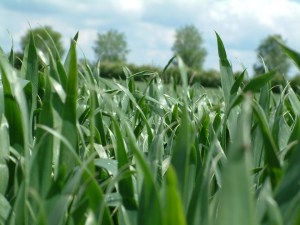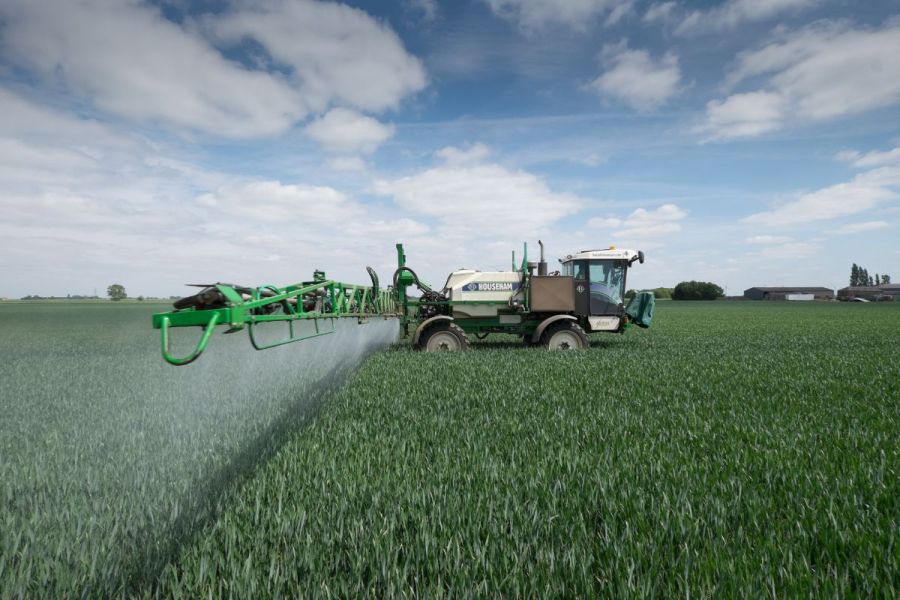Targeted use of a chlorophyll-boosting biostimulant is helping growers to off-set yield loss incurred by disease. CPM explores how putting a crop’s needs first is achieving maximum impact.
“You really can see a difference with the naked eye, which is critical in building confidence in biostimulants.”
By Janine Adamson
Consistent performance and a measurable return on investment – basics that all farmers deserve from their crop inputs. Making the most of every drop has never been so important, particularly when taking a leap of faith with products such as biostimulants.

Mark Hemmant believes designing bespoke programmes for biostimulants based on a plant’s nutritional needs, yields the best results.
Agrovista’s Mark Hemmant believes although interest in these new technologies is rapidly growing, taking a more conventional approach is key to achieving measurable impact. “Agrovista has seen the best results through designing bespoke programmes for biostimulants, based on a plant’s nutritional needs throughout its growth cycle,” he says.
“We also acknowledge that growers are looking for different outcomes depending on their individual scenario. That could be optimising N, P and K, or maximising yield to overcome challenging situations. We’ve come a long way in recent years in improving our understanding of how specific biostimulants work, this means we’re in a better place to capitalise on their individual modes of action and apply accordingly.”
A cornerstone product of Agrovista’s nutritional programmes for cereal crops is a keto-acid-based compound, Klorofill (pentanoate). Klorofill works by improving chlorophyll production, which is important in helping a plant to absorb energy from the sun during photosynthesis. This is particularly applicable when a plant is in rapid growth mode, as this is when chlorophyll production can be suppressed.
“Chlorophyll is an essential component of plant development at a very basic level, therefore we’ve included Klorofill in all three of our nutritional programmes. For winter wheat, we believe it’s best positioned at T2 at 1.0 l/ha to help produce carbohydrates, and is especially relevant for yield optimisation,” says Mark.
“We can justify this following three years of use and subsequent trials, which demonstrate consistency of performance. This is what agronomists and farmers need to see – data.”
At around £10/ha, Mark believes the product delivers solid return on investment. He bases this on a 0.4t/ha average yield uplift in winter wheat, shown in trials when used alongside a low-input fungicide programme, compared to the fungicides alone. This was demonstrated across a range of varieties including RGT Saki, KWS Extase and Sartorial.
The product continues to perform, even during high disease pressure. “In 2021, our trial site at Draughton in Northamptonshire, had a particularly bad year for yellow rust, shown in plots of KWS Kinetic. Despite the crop being severely infected, we still achieved a yield increase of 0.4t/ha using Klorofill, for both low input and standard fungicide programmes. The crop certainly benefitted, which could be seen as off-setting some of the yield loss incurred from disease,” says Mark.
With many experiencing a wet March, this season could again prove problematic for crop disease. As with all biostimulants, the product’s label can’t claim to offer curative action, however it does suggest a consistent yield boost.
For growers, the take-home message is to use biostimulants in conjunction with existing fungicide programmes, and to be selective with timings. Dr Nigel Grech is director of Unium BioScience, the company behind Klorofill. Although applicable for use at other timings, he believes the science clearly backs Agrovista’s programmed approach for the product.
“Academic studies have shown that inefficient photosynthesis can prove a bottleneck in raising the productivity of a wheat crop, and even small increases in the rate of photosynthesis can mean large increases in biomass and yield,” says Nigel.
“T2 is viewed as the most important timing for yield protection from a fungicide-use perspective, as it preserves the flag leaf and keeps it clean. Given the flag leaf is responsible for intercepting 45% of the total light energy used by the crop, boosting its photosynthetic capacity at this precise time makes complete sense.”
Nigel understands that growers will be experiencing increased pressure to cut back on ‘nice-to-have’ additions in tank mixes, but he believes taking Agrovista’s programmed approach will help to reassure.
“If you’re pinched and can only justify spraying the crop once using a biostimulant, going for the T2 timing in wheat will be most effective, once the flag leaf has fully emerged. This is because as well as upregulating chlorophyll production, Klorofill also helps plants to recover from periods of stress. For wheat, the highest risk period for physiological stress occurs in advance of flowering,” he adds.
As well as physiological stress, the crop is also susceptible to abiotic stresses such as heat and drought. For example, high temperature stress has wide ranging impacts, including reducing the grain number, starch synthesis, photosynthetic ability and chlorophyll content.
Nigel believes this further demonstrates the importance of stress relief in achieving the original objective of the product – to boost chlorophyll production and yield potential.

Leaves are a plant’s solar panels, so the larger the area, the more energy absorbed to put into growth, says John Murrie.
Aside from wheat, Klorofill is fast building a following among spring barley growers. This includes John Murrie, who farms 160ha of mostly arable land in central Scotland. “Spring barley is Scotland’s biggest crop and, unfortunately, it’s stressed from the moment it’s in the ground. If we can relieve that stress, it’s going to help no end,” says John.
“Using Klorofill, you can visibly see the crop greening up and growing bigger leaves. Leaves are a plant’s solar panels, so the larger the area, the more energy absorbed to continue growing, and so the cycle continues. It’s a great product for keeping spring barley greener for longer.”
Compared with winter wheat, Agrovista recommends an earlier application of Klorofill in spring barley – GS30-31, again at 1.0 l/ha. This is to overcome the period of physiological stress the crop experiences during stem extension and rapid growth.
John backs this advice, supported further by his role in Agrovista’s technical team. “The past three years have been about cementing the position of Agrovista’s biostimulants and optimising their use. Beyond myself as a farmer, interest and usage in Klorofill is increasing. I think that’s because you really can see a difference with the naked eye, which is critical in building confidence in biostimulants,” he explains.
John also believes that the product’s cross-crop flexibility is adding to the appeal. “Margins are really tight this year because many have bought fertiliser at inflated prices. It’s even more important to feel you’re getting value for money and that you’re not restricted to just one crop.
“However, as per the agronomic guidelines, it’s best practice to refer to a specific crop’s application timings to really get the most out of the product.”
Maintaining a stress-free spring barley crop became even more important following the loss of broad-spectrum fungicide, chlorothalonil (CTL). The active was often included in final sprays, to help prevent ramularia – a disease exacerbated by stress. Although some chemical solutions remain, growers have turned to maximising plant health and reducing stress through methods such as biostimulants.
Agrovista’s latest trial results from Draughton also champion the benefits of Klorofill in winter barley. Applied at T1 to feed variety KWS Orwell, the product achieved a 0.3t/ha yield increase, compared with untreated. Calculations have since shown that Klorofill could achieve a £63/ha margin over input cost (calculated assuming feed barley at £235/t).
Nigel believes the numbers are simply a reflection of the science. “In barley, particularly spring barley, maximising tiller production and survival will be a grower’s main concern. From a scientific perspective, the crop needs good light levels, photosynthesis and growth during stem extension, to achieve optimal tillering. “So again, that programmed approach will be proving very efficient at getting the most from the per hectare spend.”
For those with the ability to mix and match, Unium director John Haywood confirms there are advantages to be had from researching each product’s benefits and applying them accordingly.

If growers can justify spraying wheat only once with a biostimulant, T2 timing will be most effective, once the flag leaf has fully emerged, says Unium’s Dr Nigel Grech.
“We’re finding more and more growers are using Klorofill, but it’s important to recognise where we are in a season, from a crop development perspective.” he says. “If you can afford to do so, selecting alternative biostimulants for both the establishment and grain filling timings will really pay dividends.
“Thanks to the mild autumn, we’re powering through this season and many crops are looking forward. If you’re planning ahead, we’d support Agrovista’s recommendation of 3Alo T6P at T3, to maximise carbohydrate utilisation in the grain.”
T6P contains a precursor of the sugar Trehalose-6-Phosphate (T6P), which regulates metabolic and developmental processes within plants, including carbon fixation and balancing the concentration of carbohydrates.
“By relocating carbohydrates into grain within the kernel or seed, and providing more T6P, this has a positive effect on yield, whilst improving the response to environmental stresses such as drought. Unium has focused on this late season application as we believe this is when the product will have the greatest impact,” concludes John Haywood.

Bioscience in practice
As the chemistry toolbox continues to shrink, an array of new bio-solutions are coming to market, offering a range of benefits and complementary additions. Evaluating just how effective they are, and where they’re best placed can be tricky, however.
This series of articles opens a window on the science behind these innovations. CPM has teamed up with Unium BioScience to explore the background, unravel the physiological processes and provide analysis on the results of trials. Above all, these articles give the grower an inside view on some of the exciting opportunities biosolutions offer in the field.
Klorofill contains pentanoate – an organic keto acid-based compound that is a unique biological precursor to chlorophyll synthesis. Pentanoate reverses the chlorophyll suppression that a plant may experience during rapid growth or periods of stress e.g. at flag leaf stage. By increasing chlorophyll production, Klorofill maximises green leaf area and plant biomass, boosting crop growth and therefore yield.
Learn more by joining the Unium technical group here.
This article was taken from the latest issue of CPM. Read the article in full here.
For more articles like this, subscribe here.
Sign up for Crop Production Magazine’s FREE e-newsletter here.




